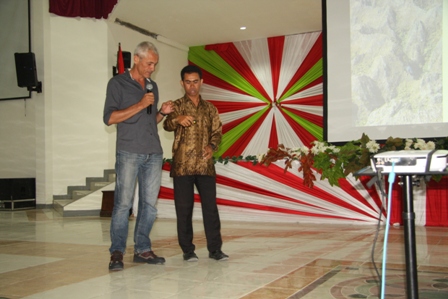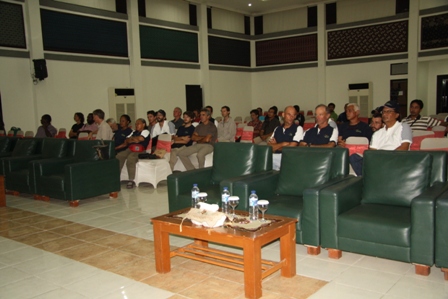Thursday 20th November, from the Airaha 2.
Today’s big event is surely the meeting with the BUPATI. But we must wait for 19 hours to make it to the ceremonial room where the ceremony will take place. To keep ourselves busy until then, Kaimana does not offer a lot of entertainment: cybercafés with fickle connections, a few shops, a market, and street displays, where we can get mangos, bananas and snake fruit. In the evening, everyone dresses up for the ceremony. The Indonesians wear batik shirts, reserved for special occasions. The men shave one after the other, gazing at themselves in the only mirror available. The women wear discreet make-up with black khol and some lipstick. What fun after weeks on the job!
The ceremony starts a bit late and goes on late into the night. After an introduction by the BUPATI, followed by a presentation by Dr Kadar, Dr Gondo and Laurent, a representative from each team gives a brief overview of the work carried out and the biological wealth observed. The purpose of the meeting is to evaluate the potential development of the region (energy production, water supplies, tourism…) and the stakes involved in conservation.
Unfortunately for those who have not been able to dominate sufficiently the Indonesian language after six weeks in the country, the presentations and speeches are exclusively in Indonesian. After two hours of talks, the French-speaking public is starting to fall asleep. But they valiantly stay awake till the end and are awarded with a buffet offering various tasteful dishes that comfort the stomach and mind.
On the stroke of 11pm, while our Indonesian colleagues are getting ready to board the ferry leaving for Sorong in the night, the Europeans board the Airaha 2 to go to Sorong as well. The dhow does not take any passengers for this long crossing and it is not possible for everyone to sleep on the Airaha 2. To simplify the distribution of the passengers, the Indonesians, more used to the ferry, use this means of transport.
(translated by Lara Denis, L2 SVC–Life & Earth Sciences–UM2, France)



